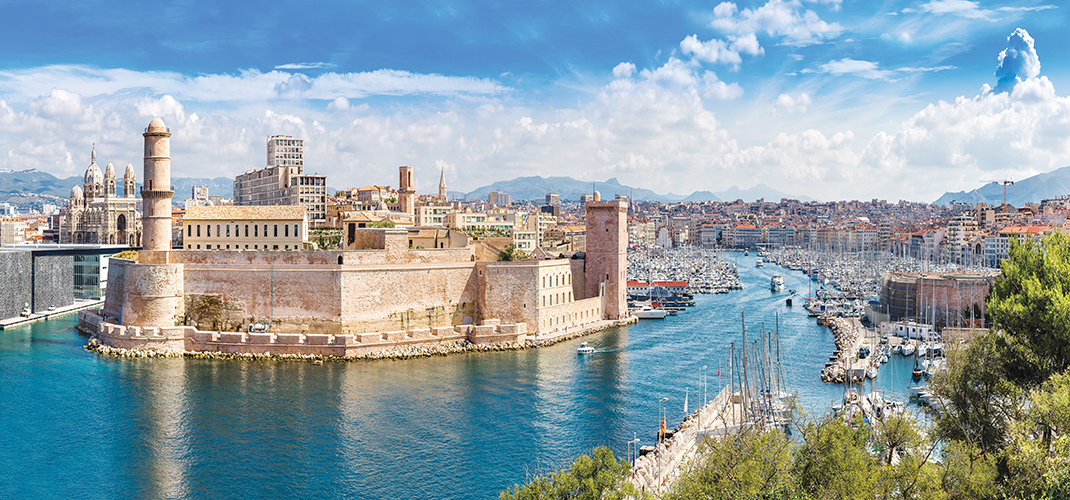Marseille

Marseille is an Old City and truly an authentic Mediterranean port town, complete with a bustling harbour. The sea is central to Marseille's existence and many of its landmarks offer views over the Bay. The city's iconic Church, the Basilique Notre-Dame de la Garde stands on a hillside overlooking the Bay. A short ferry ride from the port, the Château d'If on the Frioul Islands lures you to a serene seaside location where turquoise waters lap the pristine beaches. Marseille is definitely colourful, multi-ethnic with great shops, markets and cafés making it a fascinating place to visit.
The Vieux Port (Old Harbour) is probably the most visited part of Marseille, where most tourists take their photos, stop at any one of a number of seafood restaurants that line the broad promenades to enjoy the local speciality of Bouillabaisse or enjoy a Pastis. The Vieux Port represents the birthplace of Marseille where the city began around 600 B.C. On the east side of the harbour, the Quai des Belges holds a fish market every morning where you can buy the latest catch. Marseille has long been regarded highly for its cuisine including Bouillabaisse, a Marseille dish that is cooked all over the world. This fish and seafood stew is served with rustic style bread smothered with rouille, a kind of piquant mayonnaise and dropped into the soup.
The breathtaking 19th Century Neo-Byzantine Basilique Notre-Dame de la Garde is hard to miss as it rises above the skyline of the Old Port with a large golden statue of the Virgin and Child that graces the top of its tower. The Basilique offers spectacular views overlooking the red roof tops of the city’s buildings and Old Harbour.
Le Panier (Old Town) is situated on a hillside above the Vieux Port. This is one of the most colourful and charismatic neighbourhoods in the centre of Marseille. Le Panier is Marseille’s oldest quarter, dating back to the antiquity when the ancient Greeks settled here in 600 B.C. It has steep, winding streets with pastel buildings and an old world charm. Recently it has become one of the trendiest areas with boutiques, cafés and street art. Nearby, La Canebière is another of Marseille’s most significant areas. It is the city’s biggest avenue and it signifies the wealth that Marseille once possessed. Here you will find large, ornate buildings, elegant hotels, restaurants and shops that still show some of their previous grandeur.
Overlooking the sea, the Cathédrale de la Major (Cathédrale Sainte-Marie-Majeure) is located close to Le Panier, standing majestically on an esplanade overlooking the waterfront. This ornate Neo-Byzantine Cathédrale watches over the Old Port, with its soaring twin towers and 70 metre high dome. Commissioned in 1852 by Louis-Napoléon Bonaparte and completed in 1893, the Cathédrale is the largest Church and the only Cathédrale built in France during the 19th Century. The Cathédrale’s extravagant interior is richly decorated with Carrara marble and exquisite Venetian mosaics. At the foot of the Cathédrale is a plaza called Les Voûtes, a popular gathering place filled with trendy shops, restaurants and cafés.
La Corniche is one long terrace next to the Mediterranean, which winds down the coast, past beaches and unusual little neighbourhoods. One of the most striking sights is the Vallon des Auffes, a traditional fishing harbour that is located on a steep inlet, ringed with ramshackle old huts and accessed from the sea beneath the arches that support the road.
Heading from the Canebière station you will find one of Marseille’s most illuminating walks along the handsome Boulevard Longchamp with its upmarket 19th Century houses. Palais Longchamp and the Park around it were built to celebrate the completion of the Canal de Marseille, which linked with the Durance River that ended centuries of water supply problems for the city. You will also find the Natural Museum and Museum of Fine Arts situated here as well.
The MuCEM is a cutting edge museum opened in 2013. Its architecture is simply magnificent and has regenerated a part of the Marseille waterfront sitting next to the 17th Century Fort de Saint-Jean. The museum shows an overview of the Mediterranean culture and civilisation through is exhibitions and historic artefacts.
The Abbaye Saint-Victor was founded in the 5th Century. It is one of the oldest buildings in Marseille and its foundations date back to the Carolingian and early Christian times. The Abbaye Saint-Victor is open for visits on Tuesday afternoons and on additional days during the late summer.
Located on the Ile d’If in the Frioul Islands Archipelago is The Château d'If. This nature conservation area includes the tiny islands of If, Ratonneau, Tiboulen and Pomègues. The stunning scenery has turquoise waters, unspoiled beaches and protected coves with striking limestone cliffs. The 16th Century Château d'If was built as a fortress by King François I and soon after was converted into a prison. Those who have read the Alexandre Dumas’ The Count of Montecristo, will undoubtedly know the name of this island.
The Calanques are a great place, weather permitting to take a relaxing boat ride. This stretch of coast between Marseille and Cassis is a must see when visiting the city due to its stunning scenery and beautiful beaches that can be enjoyed whilst visiting the Parc National des Calanques. The Calanques are craggy white limestone cliffs and creeks reaching gargantuan heights and descending sharply to the sea.
